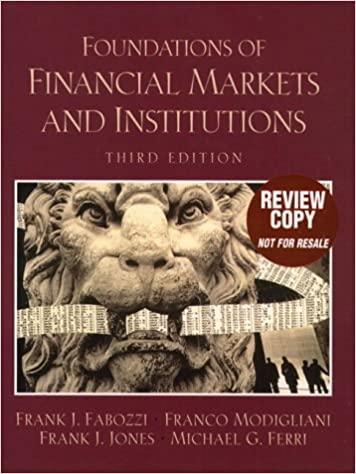Question
Part 1 A Bremond Equipment Supply Corporation (BESC) needs to determine its Weighted Average Cost of Capital in order to make a few capital budgeting
Part 1 A
Bremond Equipment Supply Corporation (BESC) needs to determine its Weighted Average Cost of Capital in order to make a few capital budgeting decisions. The firm has already established the proporation of its capital. Use these proportions in calculating the firm's WAAC.
|
| Target Market |
| Source of Capital | Proportions |
| Long-term debt | 69% |
| Preferred stock | 5% |
| Common stock equity | 26% |
Debt: BESC can sell a 15-year, semi-annual,$1,000 par value, 8.75 percent bond for $985. A flotation cost of 1.75 percent of the face value would be required in addition to the discount of $15.
Preferred Stock: BESC has determined it can issue preferred stock at $70 per share par value. The stock will pay an $8.00 annual dividend. The cost of issuing and selling the stock is $2 per share.
Common Stock: BESC's common stock is currently selling for $42 per share. The dividend expected to be paid at the end of the coming year is $5.35 Its dividend payments have been growing at a constant rate for the last five years. Five years ago, the dividend was $3.00. It is expected that to sell, a new common stock issue must be underpriced at $4 per share and the firm must pay $1 per share in flotation costs.
Additionally, the firm's marginal tax rate is 40 percent.
To help determine the firms WACC, we will break this problem down into steps:
Calculate the rate for the new bond issue, notice is has semi-annual compounding.
Calculate the after-tax cost of the bond issue.
Calculate the cost of the new issue of preferred stock.
Calculate the growth rate of the common stock dividends.
Calculate the cost of the new common stock issue.
Finally, calculate the firm's weighted average cost of capital assuming the firm has exhausted all retained earnings.
Part 1 B
Bremond Equipment Supply Corporation is now considering investment in two independent projects, A and C, which are described below. Please dont assume anything. Use the firms WACC which you just calculated to evaluate the projects.
|
| Option A | Option C |
| Initial Investment | $3,250,000 | $3,900,000 |
| Year | Cash Inflows (CF) | |
| 1 | $1,500,000 | $1,800,000 |
| 2 | 1,000,000 | 1,000,000 |
| 3 | 1,000,000 | 900,000 |
| 4 | 1,500,000 | 1,500,000 |
*Do not cut and paste this chart into your excel spreadsheet. Something in the formatting causes excel to calculate it incorrectly!
Calculate Payback Period for both projects
Calculate NPV for both projects
Calculate PI for both projects
Calculate IRR for both projects
Which project should the firm accept? Why?
Part 2
Another company is in the process of determining its WACC. For this problem you will need to use the CAPM to calculate your answer.
(This problem is completely independent of Part 1A and 1B, all the information you need is given to you in the question.)
The current risk-free rate is 2.5% and the market is expected to return 7.5% per year. The companys beta is .75. The company expects to pay 5.75% for its debt. The target capital structure for the company is 55% equity and 45% debt. The marginal tax rate is 35%.
What is the after-tax cost of debt?
What is the cost of equity?
Calculate the WACC.
Step by Step Solution
There are 3 Steps involved in it
Step: 1

Get Instant Access to Expert-Tailored Solutions
See step-by-step solutions with expert insights and AI powered tools for academic success
Step: 2

Step: 3

Ace Your Homework with AI
Get the answers you need in no time with our AI-driven, step-by-step assistance
Get Started


